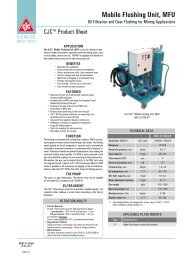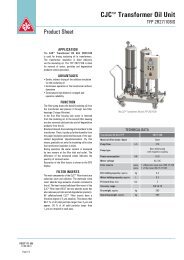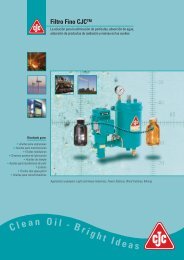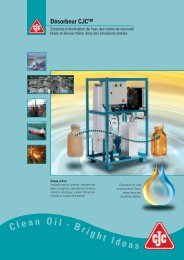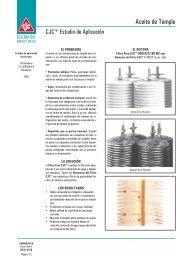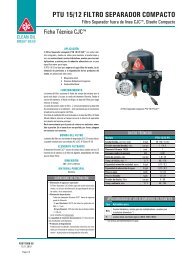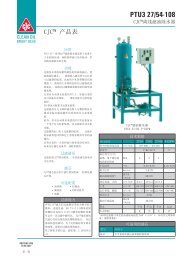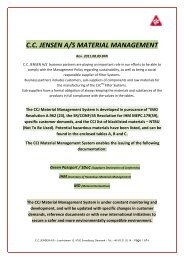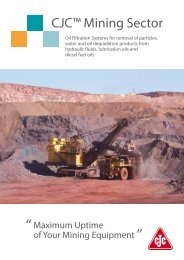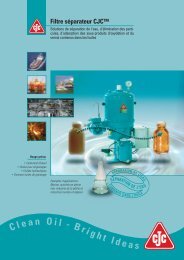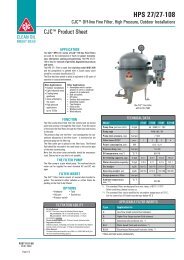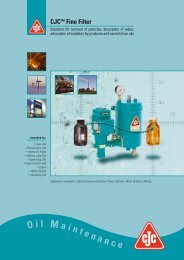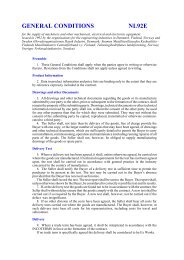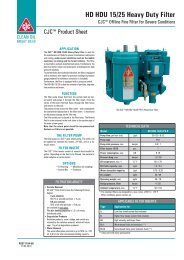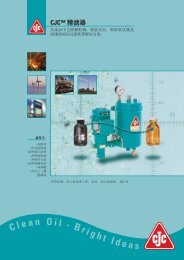DESORBER BROCHURE solutions for removal of water ... - Cjc.dk
DESORBER BROCHURE solutions for removal of water ... - Cjc.dk
DESORBER BROCHURE solutions for removal of water ... - Cjc.dk
Create successful ePaper yourself
Turn your PDF publications into a flip-book with our unique Google optimized e-Paper software.
CJC TM Desorber<br />
Solutions <strong>for</strong> <strong>removal</strong> <strong>of</strong> <strong>water</strong> from low and high<br />
viscosity oils, even in stable emulsions<br />
Intended <strong>for</strong>:<br />
Marine, Steel Works, Pulp & Paper, Mining, Power,<br />
Waste Oil Recovery Plants and Biodiesel Plants<br />
Desorption <strong>of</strong><br />
<strong>water</strong> from oil<br />
- even in stable<br />
emulsions<br />
C l e a n<br />
O i<br />
l -<br />
B r<br />
i g h t<br />
I d e a s
1<br />
The Problem<br />
Water in oil causes oil degradation, micro pitting and<br />
cavitation or breakdown <strong>of</strong> mechanical parts<br />
Problems<br />
caused by<br />
<strong>water</strong> in oil<br />
Water in oil leads to reduced viscosity, reduced filter ability, reduced lubricity,<br />
<strong>for</strong>mation <strong>of</strong> rust and bacterial growth increasing degradation <strong>of</strong> the<br />
oil. All <strong>of</strong> these factors lead to reduced lifetime <strong>of</strong> both the components<br />
and the oil.<br />
Water<br />
Contaminated<br />
Oil<br />
Abrasion<br />
Corrosion /Rust<br />
Pitting/Fatique<br />
Marine<br />
Sea<br />
<strong>water</strong> Industry Process<br />
<strong>water</strong><br />
In-line<br />
Filter<br />
System<br />
Pump<br />
Sources <strong>of</strong> Water Ingress<br />
and Contamination<br />
Leakage Through Seals<br />
Over time seals become worn,<br />
making ingress <strong>of</strong> <strong>water</strong> easy<br />
Process Water Ingress<br />
Air Vent<br />
Particles and <strong>water</strong> ingress through<br />
the air vent<br />
Internal Environment<br />
Water condenses in the oil<br />
reservoir<br />
Water Produced by Oxidation<br />
High temperature + dirty oil<br />
= Acid, <strong>water</strong> and resin<br />
Leakage in Heating Systems<br />
Leakages in steam heating systems<br />
cause <strong>water</strong> ingress in the system oil<br />
Rust / Corrosion<br />
Water instigates the <strong>for</strong>mation<br />
<strong>of</strong> rust particles, which are accumulated<br />
in the oil reservoir with resin<br />
and particles<br />
The most<br />
common<br />
types <strong>of</strong><br />
degradation<br />
caused by<br />
<strong>water</strong> in oil:<br />
Oil Degradation (Oxidation)<br />
Worn seals cause ingress <strong>of</strong> <strong>water</strong>,<br />
which at high pressure emulsifies developing<br />
varnish deposits on system parts, creating a<br />
“sandpaper-like” surface.<br />
Cavitation<br />
Cavitation occurs in areas where <strong>water</strong><br />
is present and oil is compressed; the<br />
<strong>water</strong> implodes, causing the metal surfaces<br />
to crackle and release metal particles.<br />
Principle drawing <strong>of</strong> in-line filtration<br />
Cooler Leaking Water<br />
A leaking cooler results in <strong>water</strong><br />
entering the oil reservoir<br />
The <strong>water</strong> settles at the<br />
bottom <strong>of</strong> the oil reservoir<br />
Emulsified Water in Oil<br />
Oil sample taken be<strong>for</strong>e<br />
desorption<br />
Emulsified <strong>water</strong> in oil (with<br />
density above 1) which<br />
cannot be separated by<br />
settling nor mechanical<br />
<strong>for</strong>ces<br />
Micro Pitting<br />
When <strong>water</strong> particles accumulate<br />
in the oil, viscosity changes causing<br />
metal wear, cracking and pitting<br />
<strong>of</strong> gear and mechanical parts.
2<br />
The Solution<br />
Dry oil through the CJC <strong>of</strong>f-line desorption process<br />
- even in systems with emulsified oil<br />
D10<br />
The desorption process is based on the principle that heated air can effectively<br />
hold large quantities <strong>of</strong> <strong>water</strong>. In the CJC Desorbers the oil is pre-heated<br />
and met by a counter flow <strong>of</strong> cold, dry air. The air, heated very quickly by the<br />
hot oil, will expand and absorb any <strong>water</strong> present, until saturation.<br />
D30<br />
D40<br />
Cyclone<br />
Blower<br />
Air<br />
Cooler/<br />
Condenser<br />
Desorption<br />
Chamber<br />
Emulsified<br />
oil<br />
Heat<br />
Exchanger<br />
The Desorber<br />
Operation Principle<br />
The supply pump draws oil from the<br />
oil system, and the oil is pre-heated<br />
through the heat exchanger to save<br />
energy and supplied into the top <strong>of</strong><br />
the desorber chamber and distributed<br />
evenly in the chamber.<br />
The oil temperature is maintained by<br />
an electric heater. At the same time<br />
air passes from the air pump and<br />
releases through several hundred<br />
nozzles in the bottom <strong>of</strong> the chamber.<br />
D88<br />
Electric<br />
Heater<br />
The cold and dry air meets the hot<br />
and wet oil in a counter flow.<br />
The air is instantly heated by the oil,<br />
expands and is saturated by the<br />
<strong>water</strong> in the oil.<br />
Customised<br />
Water<br />
outlet<br />
Dry oil is returned<br />
to the system<br />
The saturated air is condensed by<br />
the air cooler and the free <strong>water</strong><br />
is separated and discharged in the<br />
cyclone. The dry and cold air is reused<br />
in the closed circuit.<br />
The discharge pump returns dry oil to<br />
the main system through the heat<br />
exchanger at an oil temperature<br />
close to the original oil temperature.<br />
Desorber operation principle<br />
Oil Temperature<br />
Per<strong>for</strong>mance chart based on Mollier diagram<br />
Desorber Efficiency<br />
The desorber’s ability to remove <strong>water</strong><br />
is dependant upon oil temperature and<br />
cooling temperature, and there<strong>for</strong>e it<br />
is essential to obtain the right mix <strong>of</strong><br />
the following parameters:<br />
• Oil temperature in tank<br />
• Oil heating system<br />
• Ambient temperature<br />
• Temperature <strong>of</strong> cooling medium<br />
Water Removal
3<br />
The Result<br />
Continuous oil maintenance ensures high quality <strong>of</strong><br />
oil throughout the entire lifetime <strong>of</strong> the equipment<br />
Benefits and<br />
advantages<br />
<strong>of</strong> using<br />
CJC<br />
Desorbers<br />
The benefits obtained when installing a CJC Desorber will have a positive<br />
effect on your maintenance budget as well as increase your productivity and<br />
reduce your energy consumption.<br />
Marine<br />
Sea<br />
<strong>water</strong> Industry Process<br />
<strong>water</strong><br />
Sources <strong>of</strong> Water Ingress<br />
and Contamination Are<br />
Now Under Control<br />
Leaking Through Seals<br />
Ingress <strong>of</strong> <strong>water</strong> remains but<br />
is now continuously desorbed<br />
Process Water Ingress<br />
CJC Desorber<br />
Dry oil through<br />
<strong>of</strong>f-line desorption<br />
Dry and clean<br />
oil is returned<br />
to the system<br />
In-line<br />
Filter<br />
System<br />
Pump<br />
Air Vent<br />
Contamination can be reduced by<br />
adding an Air/Selica Gel filter<br />
Internal Environment<br />
Water still condensates in the oil<br />
reservoir - but will be desorbed<br />
Water Produced by Oxidation<br />
Low risk <strong>of</strong> developing <strong>water</strong>,<br />
acids and resin<br />
Leakage in Heating Systems<br />
Water is now removed be<strong>for</strong>e it reaches<br />
the oil system<br />
Rust / Corrosion<br />
Contamination is still being<br />
created but is removed by the<br />
CJC Fine Filter<br />
CJC Fine Filter<br />
The Off-line Fine<br />
Filter ensures clean<br />
oil by removing<br />
particles and oil<br />
degradation byproducts<br />
Principle drawing <strong>of</strong> desorption<br />
and <strong>of</strong>f-line filtration<br />
Less Maintenance<br />
Less wear and increased lifetime <strong>of</strong> components and oil<br />
Longer time between service intervals<br />
Enhanced operational precision<br />
Increased Productivity<br />
Fewer unplanned breakdowns and improved reliability<br />
Leaking coolers can be repaired at scheduled overhauls<br />
Lower Energy Consumption<br />
Lubricating capabilities remain intact and internal friction is lowered<br />
Reduced pressure drop over in-line filters<br />
Viscosity index is kept stable and efficiency is maintained<br />
-all advantages to the total economy!<br />
Cooler Leaking Water<br />
The leaking cooler can be<br />
repaired at scheduled overhauls<br />
as the CJC TM Desorber continuously<br />
removes the <strong>water</strong><br />
Clean Oil<br />
Oil sample taken after<br />
desorption and filtration
The CJC TM Desorber<br />
The CJC Desorber is <strong>of</strong> uncomplicated design and<br />
almost maintenance free<br />
Key features<br />
<strong>of</strong> the<br />
CJC<br />
Desorbers<br />
The CJC Desorbers provide <strong>solutions</strong> <strong>for</strong> <strong>removal</strong> <strong>of</strong> <strong>water</strong> in mineral,<br />
synthetic and high viscosity oils. Even in stable emulsions and in oils with<br />
a density above 1.<br />
Control Panel<br />
Desorber<br />
Chamber<br />
Process reaction<br />
chamber<br />
Condenser<br />
Releases <strong>water</strong><br />
by cooling the air.<br />
Can be supplied<br />
with different<br />
cooling media<br />
as an option<br />
Supply Pump<br />
Discharge Pump<br />
(Not visible)<br />
Placed behind the<br />
heat exchanger<br />
Main components (Desorber D30)<br />
Blower<br />
(Not visible)<br />
Supplies dry air to the<br />
desorber chamber.<br />
As an option it can be modified<br />
<strong>for</strong> inert gas, when the risk<br />
<strong>of</strong> oil degradation is high<br />
Placed behind the control panel<br />
Cyclone<br />
Water and air are<br />
separated in the<br />
cyclone and discharged<br />
Heat Exchanger<br />
Preheats the oil<br />
Main Heater<br />
(Not visible)<br />
Raises oil temperature<br />
to optimum.<br />
Variable heating capacities<br />
and media as an option<br />
Placed inside the<br />
chamber desorber<br />
Add-on options<br />
On-line monitoring <strong>of</strong> <strong>water</strong> content<br />
Automatic temperature control and optimisation<br />
Remote alarms and control<br />
Desorber can be supplied as explosion pro<strong>of</strong> version<br />
Oil absorb to guarantee oil free <strong>water</strong> outlet<br />
Customised<br />
CJC Desorber
C.C.JENSEN all over the World<br />
The CJC Off-line Filters are distributed through our own<br />
international sales organisation and designated distributors<br />
CJC<br />
stands <strong>for</strong><br />
reliable supply<br />
all over the<br />
world<br />
Denmark:<br />
UK:<br />
USA:<br />
Spain:<br />
Poland:<br />
Netherland:<br />
Ireland:<br />
Chile:<br />
Greece:<br />
France:<br />
China:<br />
United Arab Emirates<br />
Denmark<br />
Germany:<br />
Italy:<br />
Manufacturer<br />
C.C.JENSEN A/S • Løvholmen 13 • DK-5700 Svendborg • Denmark<br />
Tel.: +45 63 21 20 14 • Fax: +45 62 22 46 15 • E-mail: filter@cjc.<strong>dk</strong> • www.cjc.<strong>dk</strong><br />
Subsidiaries<br />
C.C.JENSEN LTD. • Tel.: +44 1 388 420 721 • E-mail: filtration@cjcuk.co.uk • www.ccjensen.co.uk<br />
C.C.JENSEN INC. • Tel.: +1 770 692 6001 • E-mail: ccjensen@ccjensen.com • www.ccjensen.com<br />
C.C.JENSEN Ibérica, S. L. • Tel.: +34 93 590 63 31 • E-mail: ccjensen.es@cjc.<strong>dk</strong> • www.ccjensen.es<br />
C.C.JENSEN Polska Sp. z o.o. • Tel.: +48 22 648 83 43 • E-mail: ccjensen@ccjensen.com.pl • www.ccjensen.com.pl<br />
C.C.JENSEN Benelux B.V. • Tel.: +31 182 37 90 29 • E-mail: ccjensen.nl@cjc.<strong>dk</strong> • www.ccjensen.nl<br />
C.C.JENSEN Ireland • Tel.: +353 61 374 943 • E-mail: ccjensen.ie@cjc.<strong>dk</strong><br />
C.C.JENSEN S.L. Limitada • Tel.: +56 2 739 29 10 • E-mail: ccjensen.ch@cjc.<strong>dk</strong> • www.ccjensen.cl<br />
C.C.JENSEN Greece LTD. • Tel.: +30 210 42 81 260 • E-mail: ccjensen.gr@cjc.<strong>dk</strong><br />
C.C.JENSEN France • Tel: +33 3 59 56 16 58 • E-mail: cjc.fr@cjc.<strong>dk</strong> • www.ccjensen.fr<br />
C.C.JENSEN A/S China • Tel: +86 10 6436 4838 • E-mail: ccjensen.cn@cjc.<strong>dk</strong> • www.ccjensen.cn<br />
C.C.JENSEN Middle East • Tel: +971 (0)50 453 8203, 7916 6739 • E-mail: ccjensen.uae@cjc.<strong>dk</strong><br />
C.C.JENSEN Denmark • Tel: +45 72 28 22 22 • E-mail: ccjensen@cjc.<strong>dk</strong> • www.cjc.<strong>dk</strong><br />
KARBERG & HENNEMANN GmbH & Co. KG • Tel: +49 (0)40 855 04 79 0 • E-mail: info@info@cjc.de<br />
KARBERG & HENNEMANN srl • Tel: +39 059 29 29 498 • E-mail: info@cjc.it<br />
C<br />
l e a n<br />
O i<br />
Your local CJC TM distributor<br />
l -<br />
We are represented all over the world by<br />
distributors. Find your nearest distributor<br />
on our website: www.cjc.<strong>dk</strong><br />
- or give us a call.<br />
Head <strong>of</strong>fice:<br />
C.C.JENSEN A/S • Denmark<br />
Løvholmen 13 • DK 5700 Svendborg<br />
Tel. +45 63 21 20 14 • Fax: +45 62 22 46 15<br />
E-mail: filter@cjc.<strong>dk</strong> • www.cjc.<strong>dk</strong><br />
B r i g h t I d e a s<br />
Baltzer Reklame & Grafik • 1.2 • 08



